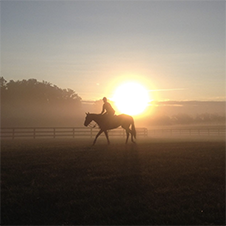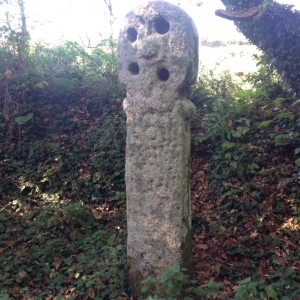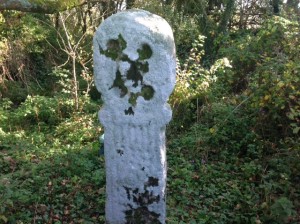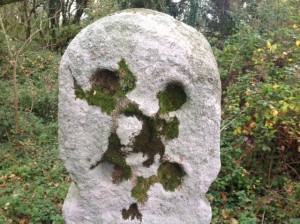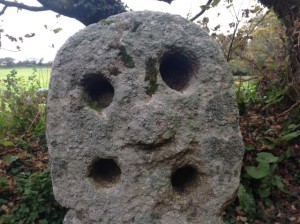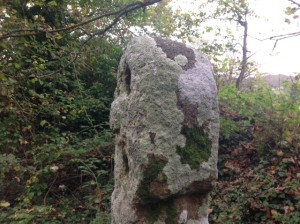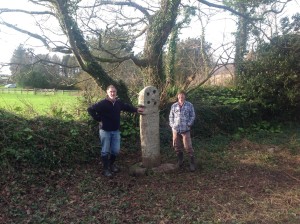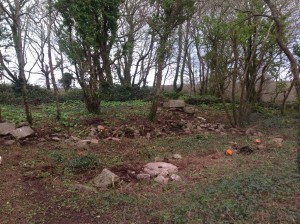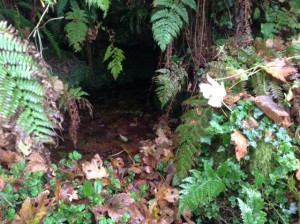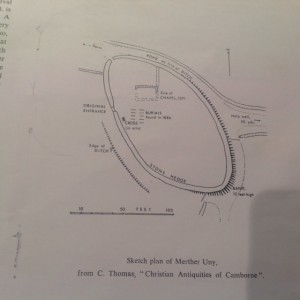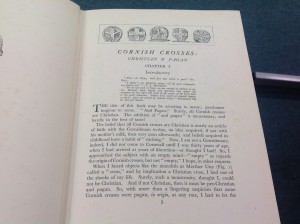There are two stone crosses in Merther Uny, near Wendron, Cornwall.
The stone cross pictured below is difficult to date, but is considered an old cross. It is in close proximity of an ancient chapel, of which little remains, within an ancient enclosure, also called a lann or round, the enclosure also includes a burial ground. The original settlement may date back to 1,000 BC.
The entire site is a scheduled monument.
The site dates back to around 1,000 BC, according to an excavation undertaken in 1968. Obviously this pre-dates Christianity, thus the site transformed from a pagan culture to a Christian culture at some point in its history.
The ancient chapel is documented to have existed in the 1300s, but could well have existed earlier. The Stone Cross is presumed to be a Christian Cross (Langdon et al); while it is difficult to date, it is presumed to be “pre-Norman”. That being said, this opinion is not universal; Drexler (1938) asserts the “monolith” is of Pagan origin, and therefore could be dated earlier. Drexler also questions whether Uny (Euny) was in fact a Christian saint (there is no documented record of his existence anywhere) but was perhaps a pagan deity. All this is conjecture, but interesting to consider.
This is a view of the front of the cross, from within the overgrown enclosure it resides. It has four indentations that form an almost perfect square.
This is a view from behind the cross. Identical markings appear.
A closer look at the head of the stone cross. More detail on the markings (additional images at the bottom of this post).
Resources that provide insight to the cross and ancient chapel site include:
Corpus of Anglo-Saxon Stone Sculpture, XI, Early Cornish Sculpture (Book), includes: “A suggestion that the cross may date from about 1000 A.D. and mark the foundation of Merther Uny chapel site appears to lack substance, especially since it is known that the cross has been re-fixed (Thomas A. C. 1968b, 81-2; Langdon, Arthur G. 1896, 346). However excavation here did establish that the small curvilinear enclosure within which the cross is located started life as an Iron Age or Romano-British round, whose earliest use as a chapel yard is indicated by finds of bar-lug pottery (Thomas A. C. 1968b, 81-2). Henderson suggested that the chapel had its own parochial limits but for some reason never attained full parochial status (Henderson C. G. 1957-60b, 476-7).”
Cornish Archaeology: 1968 Vol 7, Pgs 81 & 82, a report of the 1968 excavation, includes: “The fine standing cross of granite, 7 ft. 5 ins. overall with a sunken wheel head and a dot-and-panel ornament, must date from this time, and stands in its original pit …”
Old Cornish Crosses, by Arthur Langdon, published in 1896. Book is a free download, out of copyright. Pages 346 – 347 includes details about the cross in 1896, includes four wonderful sketches (see two images below). Classified as an Ornamented Cross with Beadwork.
Cornwall & Scilly HER, includes: “A pre-Norman decorated cross, in situ within the lann with which it is contemporary.” and “At Merther-Uny a granite cross, 2.26m high, stands in its original pit within the lann (24541.2) which it is contemporary with, just south of the original western entrance (b3). Shown on the OS map of 1963 (b2). The head, both front and back, has a central boss surrounded by a wide encircling bead, with four deep, offset sinkings, in some places cutting through the bead. The shaft is decorated …”
Heritage Gateway, includes: “Despite partial excavation, the round, medieval chapel, burial ground and standing cross 60m south east of Merthyr Uny House has already produced rare and important information regarding it use, function, re-use and longevity and will contain still more archaeological and environmental evidence regarding its use and landscape context. The cross is also a particularly well preserved, early and rare example.” and “The monument includes a round, a medieval chapel dedicated to St Uny, a burial ground and a standing cross situated on a ridge, overlooking the upper valley of the Helford River. The round and burial ground survive…” (some good additional information at this link)
Medieval Britain In 1968, 1st page of document, Pre-Conquest, includes: “the ruined walls of a reputed medieval chapel dedicated to St. Uny, and human burials. Originally it was apparently a small domestic enclosure in use from the 1st century B.C. to the 2nd(?) century A.D. About 1,000, if not before, the site was re-employed as an “enclosed development cemetery” of the familiar Cornish Lan Class.”
Merther Uny Chapel (Ancient Monument No 162), Gweek, includes: “Ruined walls of early Christian chapel. Circa C6 and later. Granite rubble. Excavated in 1968 and 1969, now overgrown and largely hidden at the time of the survey.”
Some History of St Euny from a book by Frank Michell, best resource about the life of St. Euny (Uny), includes: “The word ‘Merther’ signifies a Martyrdom, but more generally. a Chapel in honour of a martyr”. St. Euny was a well-known Cornish Saint; therefore ‘Merther Uny’ would signify either the site of his martyrdom. or burial-place, or a chapel of which he was Patron.
Euny does not seem to have been a martyr,…”
Wikipedia: Euny, includes: “Saint Euny or Uny (6th century) is the patron saint of the churches of Lelant and Redruth in west Cornwall, England, UK.” and “In a circular garden still known as “the churchyard” in which human bones have been dug up are the remains of a small chapel. Nearby is “a magnificent Celtic cross of an enriched and most original design”. This chapel is on the site of a very ancient church in honour of St Euny. After the Reformation it was allowed to decay.”
Wikipedia: Wendron, includes: “At Merther Uny was a quasi-parochial chapel of St Uny with its own cemetery.” and “Langdon (1896) recorded the existence of eight stone crosses in the parish, including two at Merther Uny.”
Times Walks: Gweek, Cornwall, includes: “we found a gateway to a walled enclosure choked with scrub, the site of a chapel dedicated to the Irish hermit. Old tales tell how …”
In Search of Cornish Relics, includes: “The Cornish place-name “Merther” refers to a saint’s shrine, so where this place-name element occurs (as at Merther Euny in Wendron) there were probably also saint’s shrines in earlier times, though there is nothing to see at any of them today.”
Saint Uny, includes: “The saint also owned two chapels, Merther Uny (SW 7034 2932) in Wendron parish by 1334, possibly connected with a well nearby (7041 2938) …”
Merther Euny – Holy Well or Sacred Spring in England in Cornwall, includes: “Take the path from Merther Euny farm and go straight on down to the woods. About 100 yards down, the well is located on your right and is built into the bank of the path you are on.” (see image below)
Cornish Crosses: Christian and Pagan, 1938, by Drexler, Considers whether some Cornish Crosses are in fact of Pagan origin. The book opens with a discussion of the Merther Uny Cross (monolith, see image below), and then dedicates an entire chapter to make the case that it is actually a pagan cross. Most other “experts” consider it a Christian cross.
Interactive: Old Map of Merther Uny
Interactive map of Merther Uny showing both Stone Crosses and site of Ancient Chapel.
Tin Streaming: 13th Century, related, as this most likely occurred in Merther Uny.
If you know anything about this cross, lan, or area, please post in the comments, and I will edit this blog to keep it updated.
